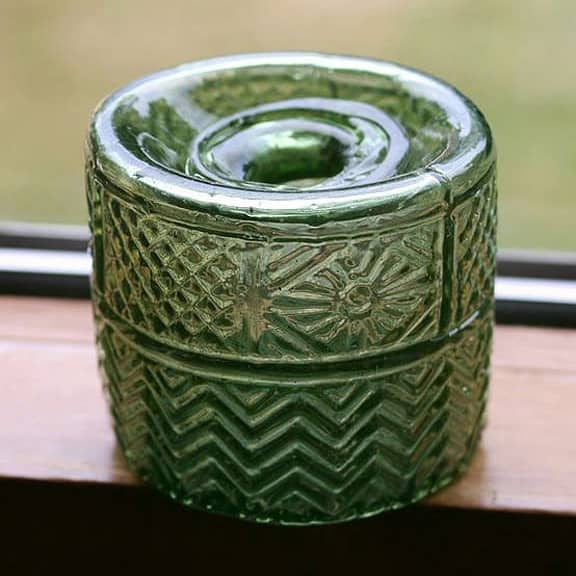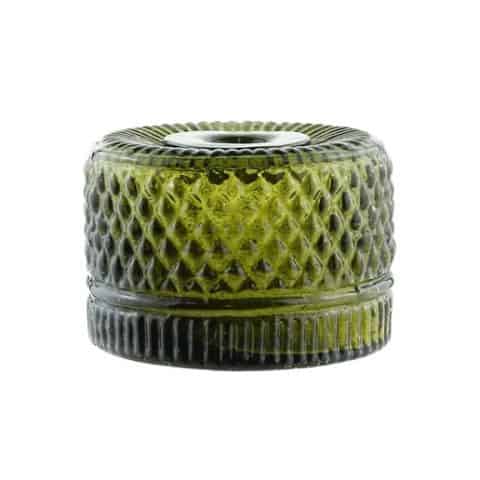GIII-25 Boston & Sandwich Geometric Ink
Boston & Sandwich
Blown Three Mold
Geometric Inkwell
GIII – 25
Attributed to Boston and Sandwich Glass Co.
Sandwich, Massachusetts
Brilliant Yellow Green
Provenance: Michael George Collection

Our GIII-25 geometric inkwell is listed in American Glass in colorless or clear glass but unlisted in this brilliant yellow-green color. There are only a few examples that exist. The consignor notes that this example came from a private collection assembled in the 1920s.
Blown three-mold glass was made primarily from 1815 up until 1840 or so, at least the pontiled examples. Our museum example of a GIII-25 geometric inkwell form was most likely blown from a glass bottle mold and measures 3 3/4 inches tall by 2 inches wide. The three-part inkwell is cylindrical with a sloping, slightly rounded shoulder, a short depressed neck, and a narrow flange. There are fifteen panels of herringbone ribbing with a ring separating three sunburst motifs (16 rays), and three blocks of diamond diapering (4 x 6). There is a ringed Type III base with a rough pontil mark. Considered very rare, the inkwell is attributed to Boston and Sandwich Glass Co. in Sandwich, Massachusetts.

The GIII-25 geometric pattern can also be found on dishes, drinking vessels like mugs and small glasses, hats, salt cellars, and sugar bowls.
See the museum example of a GII-15 Kensington Blown Three Mold Geometric Inkwell.
See the museum example of a Blown Three Mold Footed Bowl attributed to Boston & Sandwich Glass Co.
Boston & Sandwich Glass Co.
The town of Sandwich was settled in 1637 and incorporated in 1639 and is the oldest town on Cape Cod. Initially settled by the English, Sandwich became an agricultural community, with its main export of timber sent back to England. It remained a primarily agricultural community, supplemented by coastal fishing during the American Revolution.
In 1825, the landscape of Sandwich would drastically change because of Deming Jarves, a Boston businessman and former agent of the New England Glass Company of East Cambridge, Massachusetts.
Read Yours Truly, D. Jarves–A Glassmaker’s Gifts by Elizabeth and Frank Creech, FOHBC Bottles and Extras, March–April 2014
Read Another Look at Sandwich Glass by Eric McGuire, FOHBC Bottles and Extras, November–December 2017
Deming Jarves did not choose Sandwich as a site for the glass factory because of the readily available beach sand, which is too impure to make glass that needs silica. The company shipped in pure silica supplies first from New Jersey and New York and later from the Berkshire Hills in western Massachusetts. Jarves also chose Sandwich because of its proximity to a shallow harbor and the possibility of a canal being built through Cape Cod to allow for the shipment of goods. The local availability of timber could be used to fuel the glass furnaces. Even the salt marsh hay and grasses could be used for packing material.
Jarves brought master glassblowers with him from the New England Glass Company. He also recruited workers from England and Ireland. English and Irish glassmakers were considered the foremost craftsmen during the early 19th century. They were very skilled in making blown glassware with high lead content, the most desirable of the period.
Primary Image: The GIII-25 Blown Three Mold Geometric Inkwell imaged on location by Alan DeMaison, FOHBC Virtual Museum Midwest Studio
Support: Reference to American Glass by George S. and Helen McKearin, Crown Publishers Inc., New York, 1989.
Support: Reference to American Bottles and Flasks and Their Ancestry by Helen McKearin and Kenneth M. Wilson, Crown Publishers, New York, 1978.
Support Image: Auction Lot 18: Blown Three Mold Inkwell, probably Keene Marlboro Street Glassworks, Keene, New Hampshire, 1820-1830. Cylindrical, greyish moonstone, tooled disc mouth – pontil scar, ht. 1 3/4 inches, dia. 2 inches. GIII-25. Probably the exact example pictured in Covill’s “Ink Bottles and Inkwells” pg. 290, fig. 1220. Fine condition. Ex Orin Summerville collection, ex Bob Mebane collection. – Norman Heckler Jr. & Sr., Norman C. Heckler & Company, Auction #106
Support Image: Auction Lot 5: BLOWN-MOLDED GIII-25 HAT OPEN SALT, wide folded rim, Ringed Type III base with rough pontil mark., cobalt blue, Boston & Sandwich Glass Co., Circa 1825-1835. Undamaged. 2 1/4″ H, 2 3/8″ D rim. Provenance: The Joan E. Kaiser Collection of Sandwich and related glass (Acc. #86.26). Barlow/Kaiser – The Glass Industry in Sandwich, Vol. 1, p. 278, fig. 1435 (retains publication label). – Jeffrey Evans, Jeffrey S. Evans & Assoc., May 20, 2017
Support Image: Auction Lot 165: BLOWN-MOLDED GIII-25 OPEN SALT, galleried rim and a pinched foot, Ring Type III base, rough pontil mark. Colorless, Boston & Sandwich Glass Co. Circa 1825-1835. Undamaged with some minor wear. 2 1/4″ H, 3″ D rim, 2″ D foot. Provenance: From the Don Kelly collection, Altamont, N.Y. – Jeffrey Evans, Jeffrey S. Evans & Assoc., November 15, 2019
Support Image: Auction Lot 164: BLOWN-MOLDED GIII-25 OPEN SALT, compressed angular bowl with everted rim, raised on a short drawn stem and flared foot, Ringed Type III base with rough pontil mark. Brilliant deep cobalt blue, Boston & Sandwich Glass Co., Circa 1825-1835. Very good condition overall with a chip, flake, and a few minute nicks to the rim edge. 1 3/4″ H, 2 1/2″ D rim. Provenance: From the Don Kelly collection, Altamont, N.Y. – Jeffrey Evans, Jeffrey S. Evans & Assoc., November 15, 2019
Support Image: Auction Lot 235: BLOWN-MOLDED GIII-25 NAPPIE, having a folded rim and Ringed type III base with rough pontil mark. Colorless, Boston & Sandwich Glass Co., Circa 1825-1835. Undamaged, with light wear. 1 1/2″ H, 6 1/4″ D rim. Provenance: Property of Art & Kathy Green. Northeast Auctions, Portsmouth, New Hampshire, 4/1/05, lot B77. Ex-collection of Pamela and Donald Levine (retains collection sticker). – Jeffrey Evans, Jeffrey S. Evans & Assoc., May 20, 2015
Support Image: Subject inkwell on a window ledge. Photograph by Michael George.
Support: Reference to Ink Bottles and Inkwells, William F. Covill, Jr., 1971
Join the FOHBC: The Virtual Museum is a project of the Federation of Historical Bottle Collectors (FOHBC). To become a member.


























